In the penultimate round of 16, Morocco and Spain met at the Education City Stadium. Morocco won the last matchday of Group F with a victory over Canada. Spain, on the other hand, lost 2-1 to Japan, just like Germany after taking the lead.
In a group with Croatia, Canada and the favoured Belgians, the North Africans remained undefeated and entered the last 16 as group winners with seven points. The Spaniards were delighted to progress thanks to their superior goal difference after beating Costa Rica. However, with only four points from three games, the Roja have so far fallen short of their expectations.
The two teams have met once in their history: four years ago in Russia. On the third matchday of the group stage, the game ended in a 2-2 draw, with Spain advancing to the knockout stage and Morocco heading home.
After a long defensive struggle, Morocco prevailed on penalties. This is the first time they have reached a quarter-final. Sevilla goalkeeper Bono saved all three of the Spanish penalties. Besides him, Amrabat was particularly convincing in his performance.
In this tactical analysis article, we will focus on Morocco’s defensive tactics and their transition situations. We will also take a closer look at the Spanish offensive play. But first, we will start the analysis by introducing the two lineups.
Lineups
Walid Regragui set up his team in a 4-3-3 system, which repeatedly became a 4-1-4-1/ 4-5-1 in defence. Sevilla FC’s Bono played in goal and the back four in front of him was made up of Achraf Hakimi from PSG, Nayef Aguerd, Romain Saiss and Noussair Mazraoui. Sofyan Amrabat, Azzedine Ounahi and Selim Amallah formed the three midfielders and Hakim Ziyech and Sofiane Boufal started on the flanks. The only nominal striker was Youssef En-Nesyri.
Luis Enrique also lined up his team in a 4-3-3 system. Unai Simon started in goal and his defenders were Marcos Llorente, Rodrigo, Aymeric Laporte and Jordi Alba. The midfield three consisted of three Barcelona players with the captain Sergio Busquets and the two young talents Pedri and Gavi. The offensive line was made up of Dani Olmo, Marco Asensio and Ferran Torres.
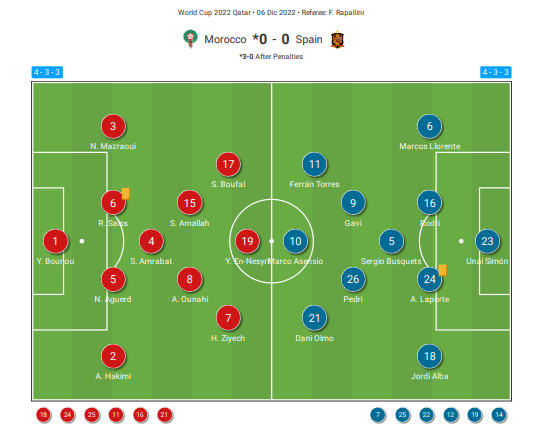
Marocco´s defensive performance
Morocco have already impressed with a strong defensive performance throughout the tournament. They have only conceded one goal so far and have only allowed two shots on goal. Against Spain, they were again able to convince defensively and pose problems for their opponent’s offensive.
Against the Spaniards with their possession football, they stood compactly in their own half in a 4-1-4-1 or 4-5-1 system. The main focus was on taking the three creative midfielders Pedri, Gavi and Busquets out of the game.
By supporting their own striker, they were able to create an overabundance in midfield and thus stop the Spanish build-up of play through the centre. They ran the ball at the Spanish defenders and rarely put them under pressure.
Busquets was locked in a diamond between the striker, defensive midfielder and the other two central midfielders during the build-up. The Moroccan striker worked a lot with his cover shadow in which he could mark Busquets.
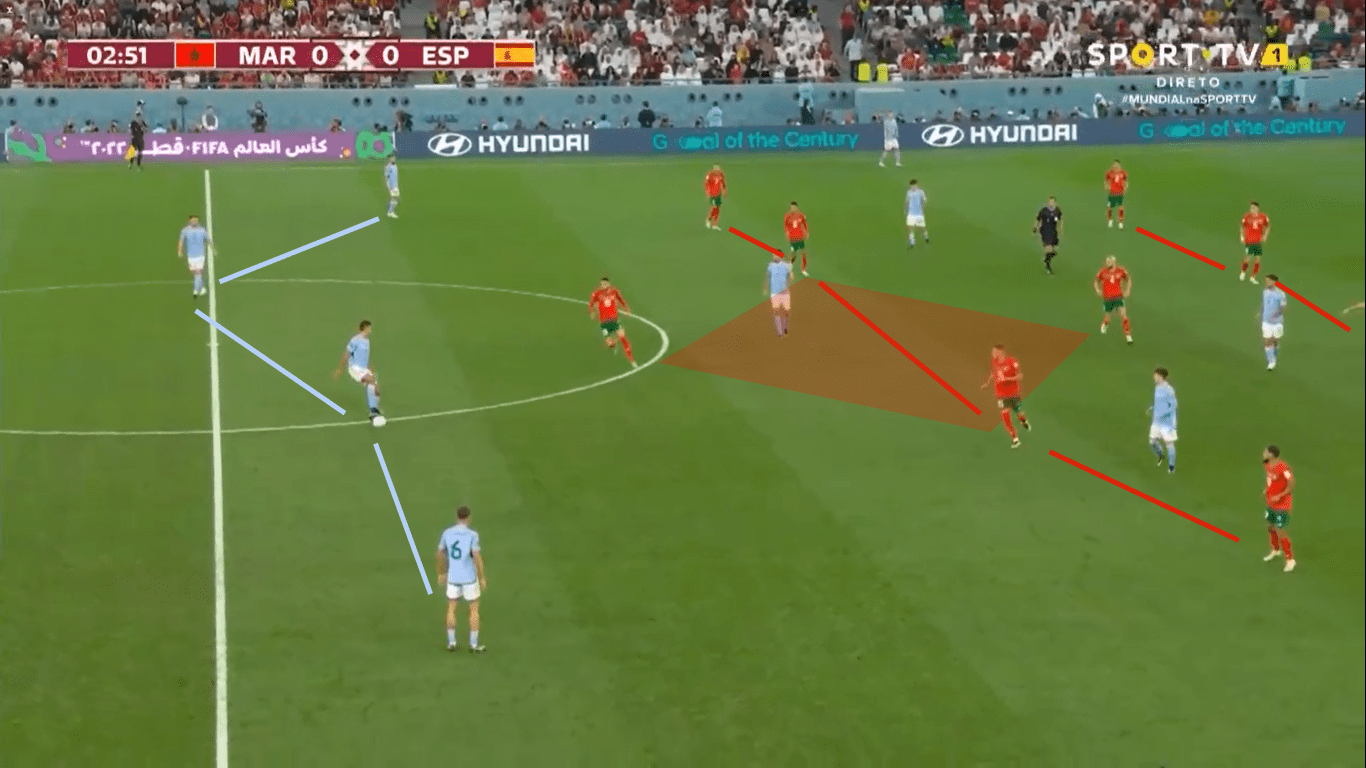
Here you can see well how Busquets is locked in this opposing diamond. Right at the start of the game, Spain ran the ball through their own ranks to set up their opponents.
While the Moroccan striker restricted himself to making sure Busquets did not get the ball, the two central midfielders ran at the respective centre-backs on the side.
In their 4-1-4-1 system, they had Amrabat as a defensive midfielder, someone who could provide further security across the width in front of the defence. If one of the two central midfielders ran at the opposing centre-back, he could also mark with his cover shadow.
If the opposing central midfielder moved out of the covering shadow, he could be run at by Amrabat. It was important for Morocco that he could not turn and was disturbed directly when he received the ball. This allowed the overplayed players to move up and strengthen the defence.
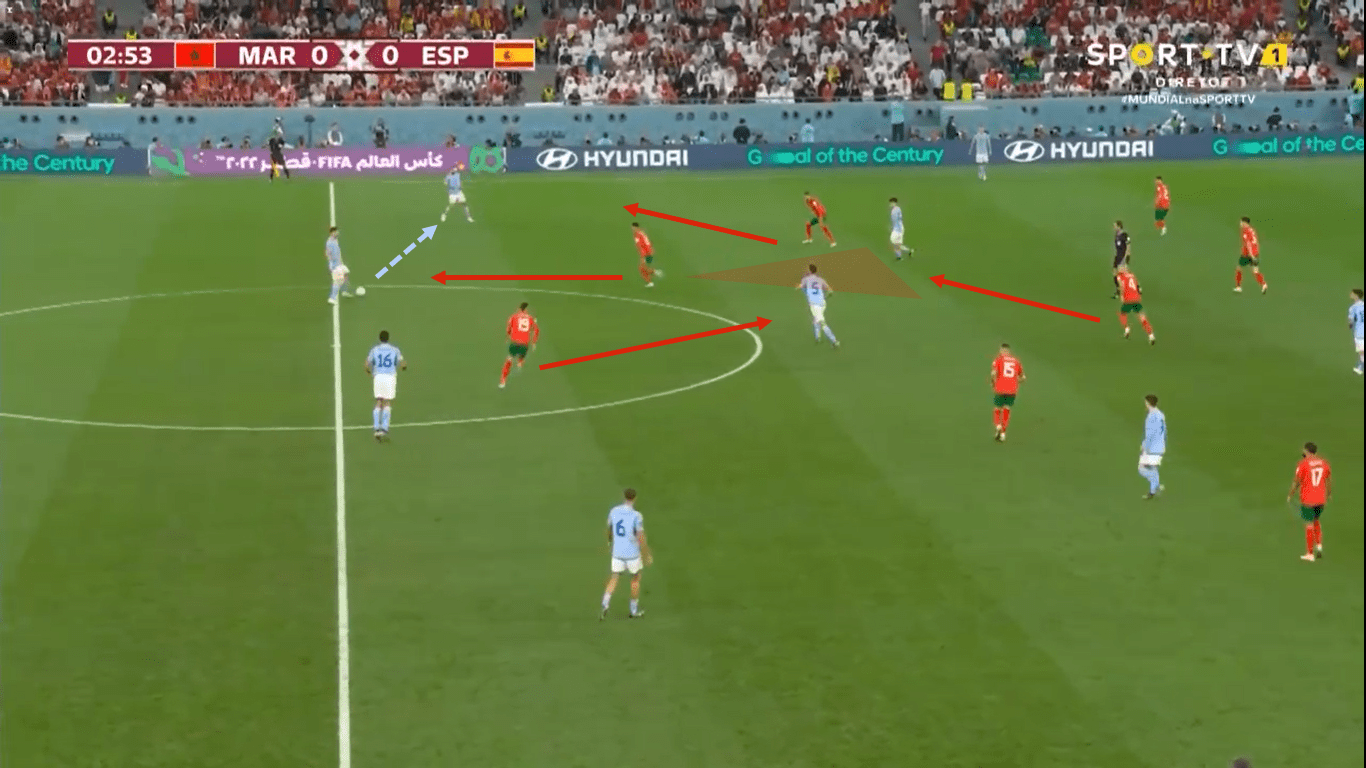
In the next picture, you can see the Moroccans’ run-up behaviour very well. By shifting the ball to the left Spanish side, the running forward drops back to mark Busquets.
The Morocco right central midfielder continues to have the Spanish left back in his cover shadow as he runs at the left central defender. The right midfielder also marks this but is already prepared to press the left defender.
In general, they kept trying to put Spain under pressure in their possession phases. This created spaces again and again, but they were always able to close them through a clear distribution of tasks and good attacking.
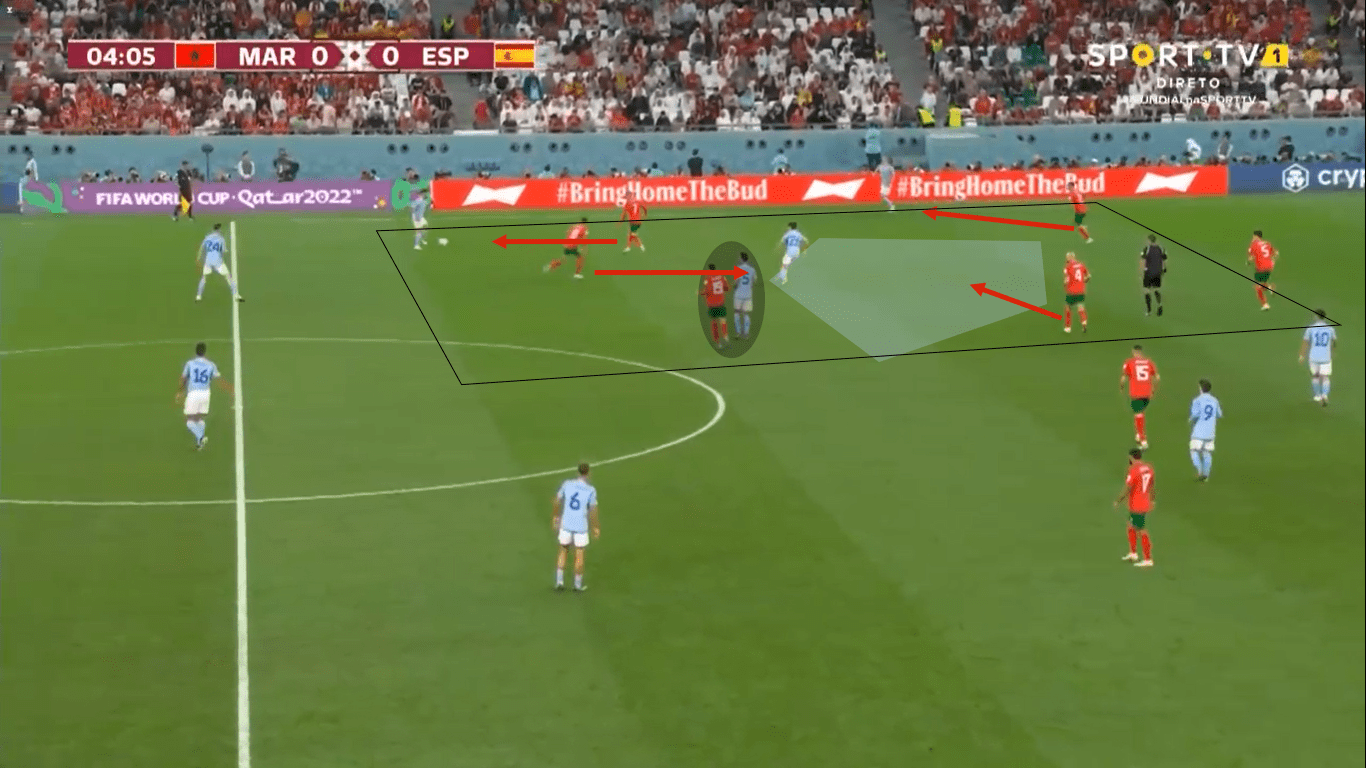
You can see the generally compact shifting of the Moroccans against the ball. They have a clear division of how they run at the opponent and what the other players have to do off the ball.
The right midfielder now presses the left defender and the midfielder who was just running in drops back. The midfielders’ running out creates a gap behind them, but this gap can be attacked by the aforementioned Amrabat.
It is also noticeable that Morocco repeatedly tries to create an advantage on the side near the ball. In this way, they can repeatedly press the Spaniards in midfield and possibly force them to make mistakes in order to be able to switch quickly afterwards.
Also on the flanks, two players came together, again and again, to be able to create in the defence in 2vs1 against the technically strong Spaniards. This support could also be seen in the last minutes of extra time.
Spain’s opportunities with the ball
Spain had 70% possession throughout the game. From these long periods of possession, they could only create a few scoring opportunities against Morocco’s well-organised defence. The ball often ran only through their own backline.
The fact that the Spanish were outnumbered in the centre of play created spaces on the outside. Nevertheless, they tried to create spaces in the centre of the Moroccans by playing long ball sequences, so that Busquets could be involved in the game as a ball distributor.
If the ball could be played into the centre to Busquets, he could turn. Then he could distribute the ball to the outsides. In this way, they tried to create a surplus on the wings in order to get dangerously into the opponent’s third.
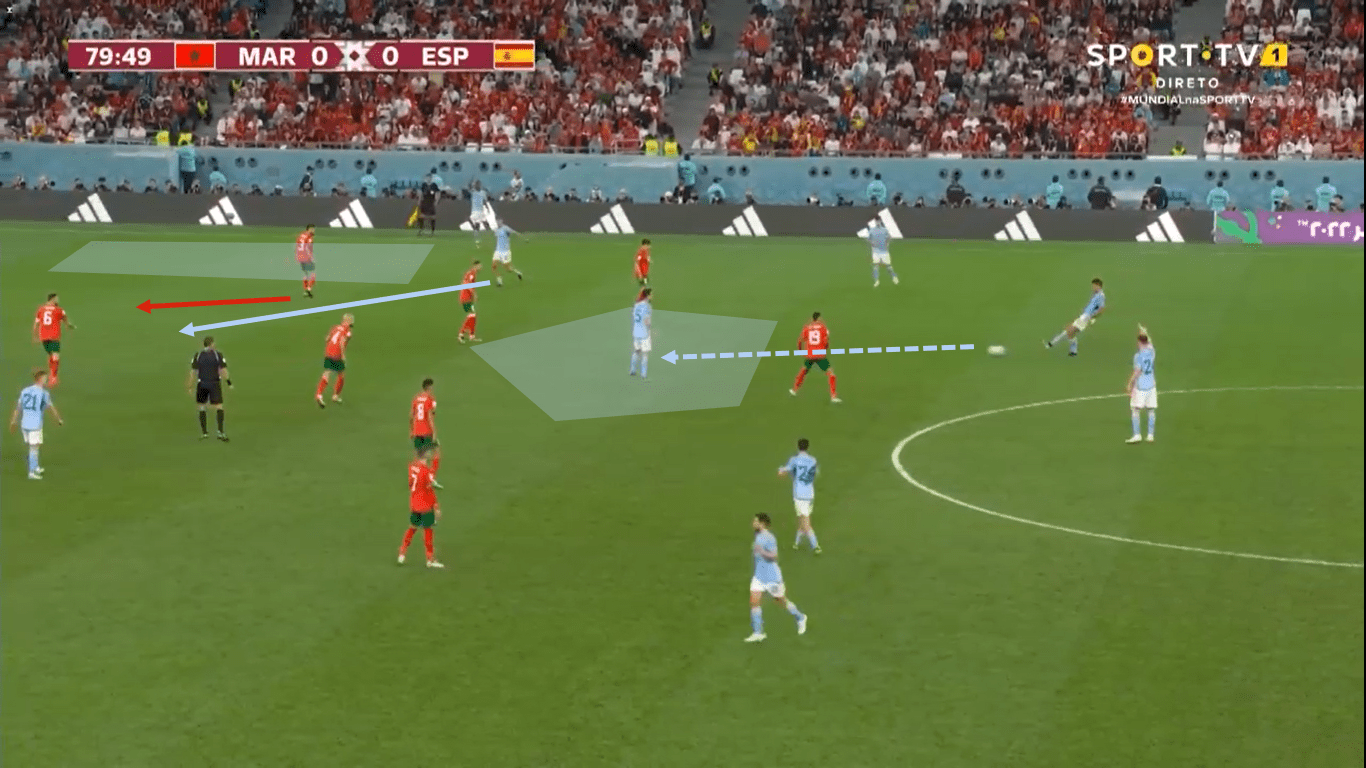
As we have seen before, Busquets was repeatedly covered by four opponents and therefore had only a few shares in the build-up of the game. However, when he could be used. as in this scene, it was quite dangerous for the Moroccan backline.
Here, the Moroccans were not close enough to him and he was able to turn up with the ball. Meanwhile, the right defender pushed along to the last line and there a 2vs1 developed on the wing.
By running the defender deep, he takes the winger’s actual opponent with him and creates space on the wing. Busquets thus has two options: Either he plays the ball into the space created or plays it deep to the starting Llorente.
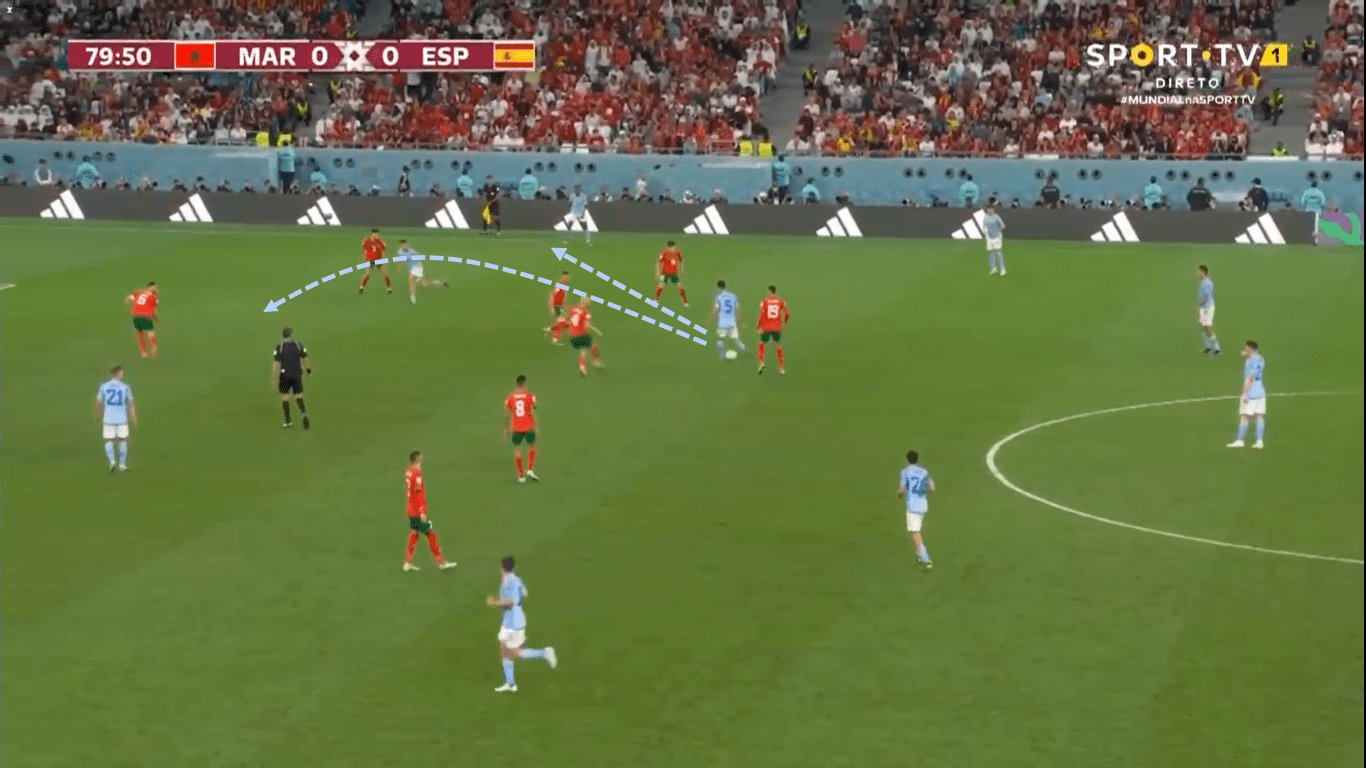
Here you can see the options just described for Busquets after he has been able to turn. The Moroccan players give him too much space for this. A complicated task arises for the Moroccan left-back, which free space he now defends.
Another method that could be seen again and again in the build-up play was the following: Here, Pedri, as the right central midfielder, dropped to the position of the right defender. Llorente, as the actual right-back, then shifted to the last line to create space for Pedri.
Torres, the right winger, then dropped as well and positioned himself on the right flank. So the Spaniards tried again to create a superior number on the wing and to pull apart the Moroccan defensive lines.
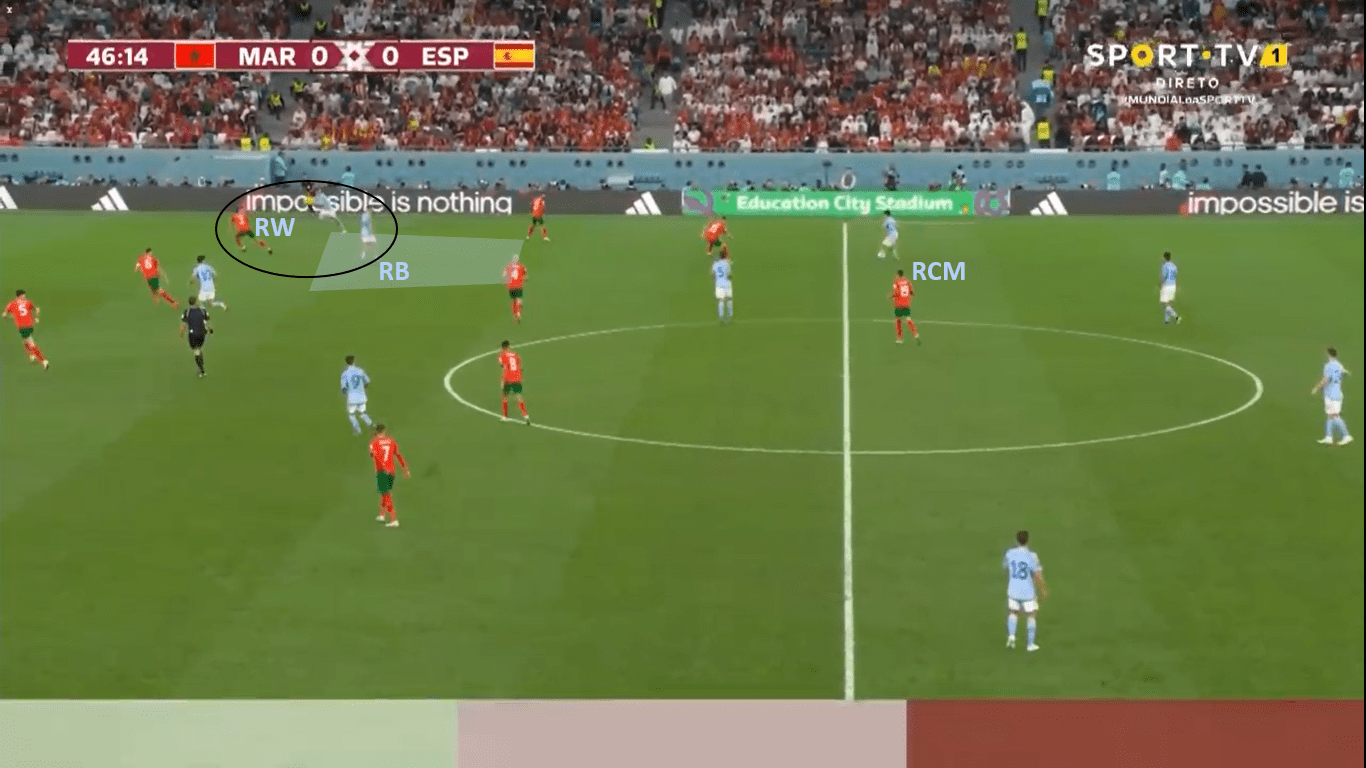
Here you can see Pedri dropping back in the build-up and the right-back pushing into the space between the chains. This creates another 2vs1 on the wing.
This time the defender does not start deep but stands in the space between the chains. If he can be played to, he can turn. In this case, it is again difficult for the defender to know how to act.
Spain tried to create such situations again and again, but often had problems doing so because Morocco did not often give away these spaces.
As a last discernible resort, Spain used the deep runs of the offensive players. As Morocco tried to keep the spaces between their two chains tight, the back line kept moving up.
This created large spaces behind the defence into which the forwards could start. Often the offensive players did not stand directly at the level of the last line but started already in the space in front of the defence.
In this way, they tried to avoid being placed offside. The short run-up from midfield also allowed them to develop speed advantages over the defenders.
In the second half, the Spaniards were no longer able to use this means as clearly, as the Moroccans lined up deeper to also be able to defend the deep runs better.
Spain, however, had problems with the Moroccans’ compact defence, regardless of the means they used. As a result, they rarely had any dangerous goal-scoring opportunities in the game.
Marocco´s chances after winning the ball
Morocco tried, again and again, to switch quickly after winning the ball in midfield. Due to the nominal superiority in the centre, they were in a good position to start a counterattack.
The two central midfielders Gavi and Pedri were often positioned higher up the pitch than Busquets. As already mentioned, Busquets was always in a diamond of opposing players.
This meant that Busquets was on a line with two opponents. Although from Spain’s point of view, this superiority also existed on the Moroccan defensive midfielder’s line, this superiority was less advantageous for backward movement.
Morocco’s central players kept attacking the balls played into the spaces and were also able to win the balls there. After winning the ball, the two outer midfielders started immediately to be able to create face-off options.
This was another reason why Spain did not take any risks throughout the game and tried to keep their full-backs flat and thus maintain an equal number in the rest of the defence.
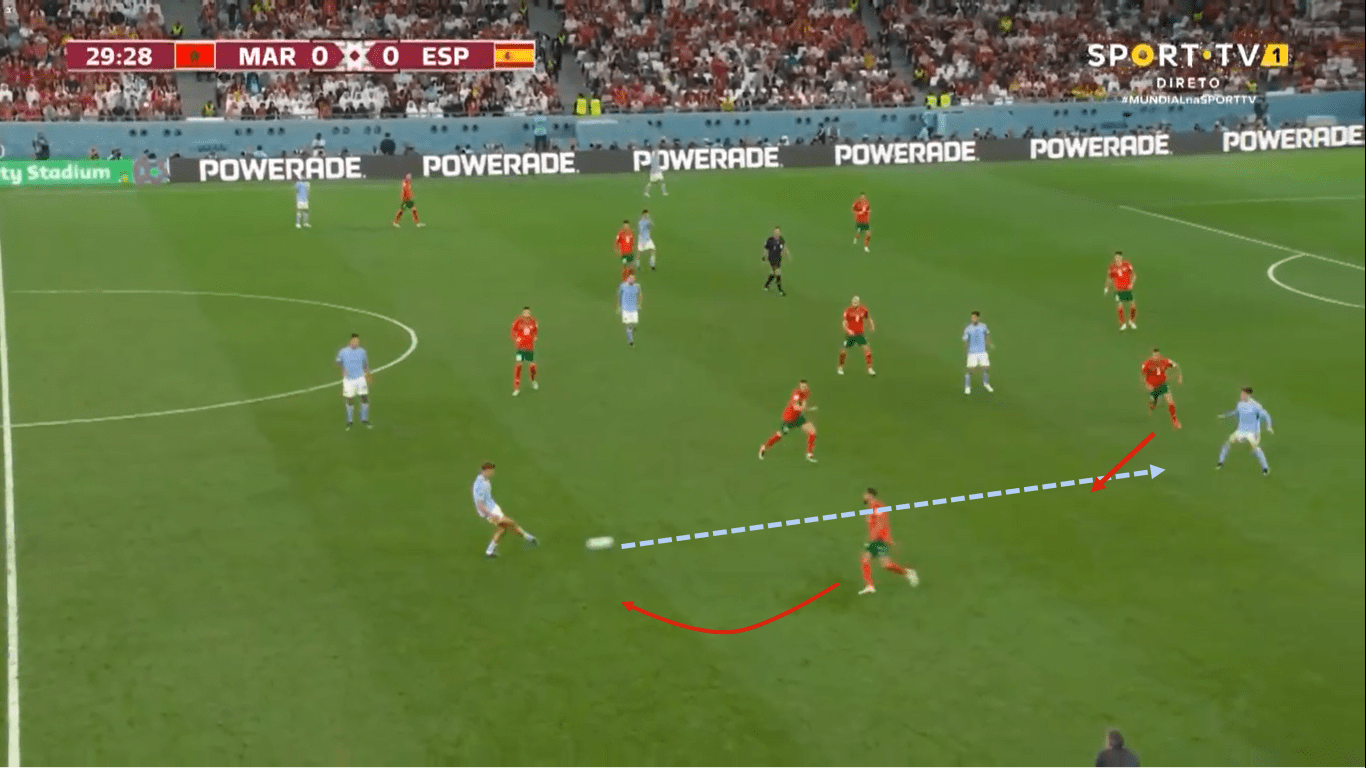
Here, you can see well how Morocco were able to convince again and again not only by their running on but also by attacking the balls played into the gaps. Spain had all their players except the four defenders positioned deep in the opponent’s half.
The left midfielder’s running cut the passing path to the Spanish winger positioned behind him. It can therefore be seen that only the ball can be played into this space or back again. The centre-back also recognises exactly this situation and defends well forward.
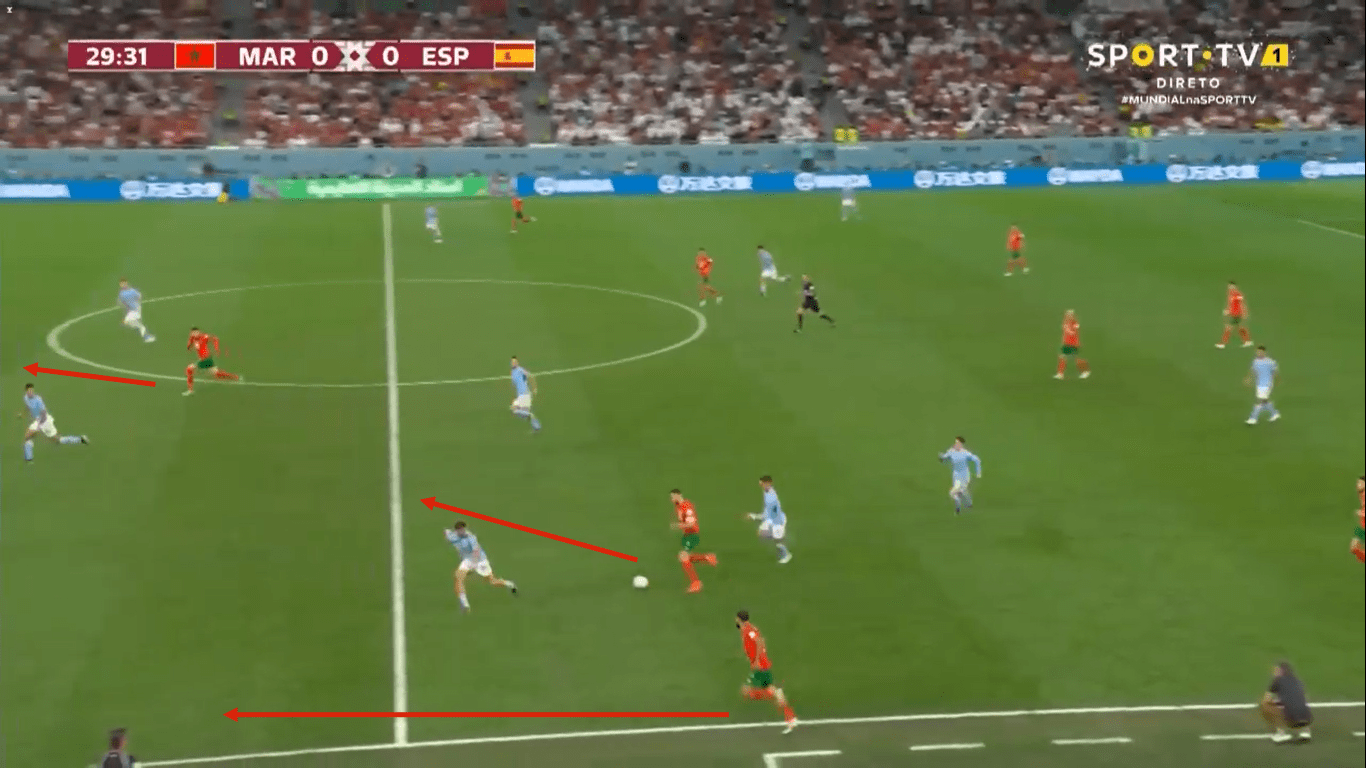
After winning the ball, the player who won the ball goes directly into the forward movement. Next to him, the striker and the left midfielder also start. The Moroccans’ goal was often in the game to be able to cause problems for the Spaniards with their switching game.
In addition, the two midfielders who are far from the ball can also intervene in order to create an advantage or an equal number of players. Morocco could have played such situations even better in the game to get dangerously in front of the opponent’s goal.
Conclusion
Finally, we will summarise the most important tactical points that have just been analysed:
Before the match, Morocco had set themselves the goal of taking playmaker and ball distributor Sergio Busquets out of the game. They repeatedly positioned themselves around him in such a way that he either could not be played at all or could only bounce directly.
In general, they were completely convincing with a strong and compact defence. The run-up behaviour was just as important as the man and space defence in the centre. Morocco could have been even more efficient in switching play after winning the ball in the centre.
Spain had the ball a lot and played more than 700 passes in the 90 minutes, but still could not get in front of the opponent’s goal often enough. The reason should not be solely that their midfield strategist was taken out of the game.
After 120 minutes, Morocco continued to go without conceding a goal in this match and eventually won in a penalty shoot-out, in which Spain missed all three penalties. Morocco, however, also had no more real switching moments to be able to decide the game beforehand.
This is Morocco’s first quarter-final and they will meet the winner of the last 16 between Portugal and Switzerland on Saturday.





Comments